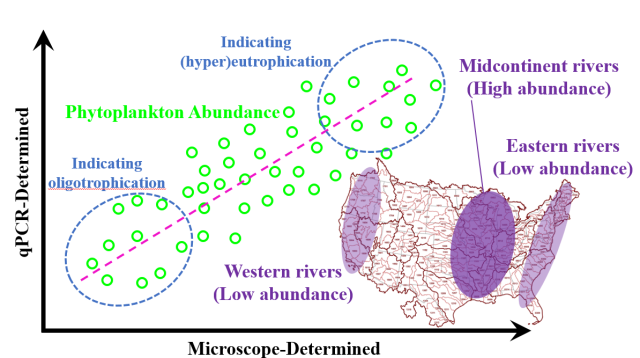A New Way to Measure Phytoplankton and Cyanotoxin Producers in Large Rivers
Published March 12, 2025

Aquatic ecosystems, especially rivers, ponds, lakes, and reservoirs, can have variable levels of biological productivity that is directly proportional to their nutrient levels, or “trophic state”. The waterbodies’ states can vary from oligotrophic A water body or habitat with low concentrations of nutrients. — crystal clear waters with very low nutrient levels — to eutrophic — nutrient dense, murky pools covered in algae growth. Eutrophication The process of excess nutrients accelerating the growth of algae, ultimately depleting the water of dissolved oxygen. can deteriorate water quality, damage ecosystems, harm aquatic animals, compromise drinking water safety, and threaten public health. Monitoring trophic state is critical to the protection of water resources. Among the many methods for monitoring, phytoplanktonic (microscopic algae) composition and abundance can comprehensively indicate the trophic status.
Cyanobacteria, informally known as blue-green algae, are important to a variety of organisms and to the food webs they support; however, excessive growth of cyanobacteria can lead to “blooms”. Some of these cyanobacteria produce highly potent toxins, known as cyanotoxins, that can cause health problems for humans and animals. Even a small proportion of toxic cyanobacteria or cyanotoxin producers can cause cyanotoxins to accumulate in river food webs. Given the impacts these blooms can have on water bodies and local economies, it is important to develop efficient tools to identify and quantify phytoplankton Small, usually microscopic plants (such as algae), found in lakes, reservoirs, and other bodies of water. and cyanotoxin producers with rapid, accurate and high throughput technology to evaluate the water trophic status, water quality, and assess the potential risk of cyanotoxin production. In collaboration with the U.S. Geological Survey (USGS), EPA researchers applied newly developed tools to understand cyanotoxin producers in large rivers in the United States. These tools may offer substantial advantages over traditional, slower methods.
Analyzing the Data
EPA researchers collaborated with scientists from USGS to understand algal bloom and toxic cyanobacteria at 12 river sites in the contiguous United States from 2017 through 2019 using molecular tools developed and evaluated in an EPA laboratory. These sites include a range of drainage areas, streamflow conditions, and biological productivity. The analysis explored the composition and quantity of cyanotoxin producers, the geographic distribution of these cyanobacteria and their association with river characteristics (e.g., nutrients, flow rates). The analysis also evaluated different tools used in the identification and quantification of phytoplankton abundance and the role of quantitative polymerase chain reaction (qPCR)-based abundance for determining trophic status of river water.
To gather overall perspectives on river microbial communities, researchers aimed to reveal all potential cyanotoxin producers using a metagenomics-based approach (deep sequencing of all DNA present in the river). They identified the dominant genotypes of microcystin producers, a common toxic species, by sequencing a specific microcystin-producing gene. Working off of the foundation laid by the metagenomics, researchers wanted to evaluate the use of qPCR assays in algal identification and quantification against the conventional “gold standard” method, microscopy. Using a microscope (microscopy) is an excellent way to identify phytoplankton and cyanobacteria, but the use of this method takes a lot of time to process samples, requires years of experience, and lacks accuracy and high throughput workflows.
Finally, researchers wanted to evaluate the use of qPCR-based abundance as an indicator of the trophic status in these river waters. Various water characteristics can help scientists evaluate trophic status of freshwater such as the levels of chlorophyll a. Chlorophyll a is used to estimate the concentration of algae and cyanobacteria growing in a waterbody. Quantifying chlorophyll a as a proxy for phytoplankton abundance, trophic status, and algal blooms is more efficient and less expensive than microscopic counts, but it does not tell researchers if the algae are harmful. qPCR, in contrast, can both enumerate and identify species — serving as a more comprehensive and high throughput option for evaluating trophic status.
Results

These are the first studies characterizing and mapping cyanotoxin producers, correlating qPCR-based algal abundance, microscopic data, and chlorophyll a in river environments. The research shows high abundance of phytoplankton and cyanobacteria along with high levels of cyanotoxins are present at sites with the highest trophic level. Researchers’ analysis also revealed higher phytoplankton abundance in the rivers located in the midcontinent region. The study found these rivers to be more eutrophic than the other regions studied. This work shows that qPCR-based phytoplankton abundance correlates well with microscopic cell counts and chlorophyll a levels. As cyanobacteria-related events increase, they are expected to pose additional challenges to inland water quality. By linking qPCR-based phytoplankton abundance to microscopic counts and chlorophyll a, this study demonstrates that qPCR is a promising avenue to assess the abundance and community composition of phytoplankton of freshwater rivers. The combined efforts of EPA and USGS provide a unique perspective on phytoplankton, cyanobacteria, and potential toxin-producing cyanobacteria in large U.S. rivers and can help scientists and water quality managers make better informed decisions.
Learn more
- Using cyanobacteria and other phytoplankton to assess trophic conditions: A qPCR-based, multi-year study in twelve large rivers across the United States (2023)
- Metagenomic mapping of cyanobacteria and potential cyanotoxin producing taxa in large rivers of the United States (2023)
- Harmful Algal Blooms Research
